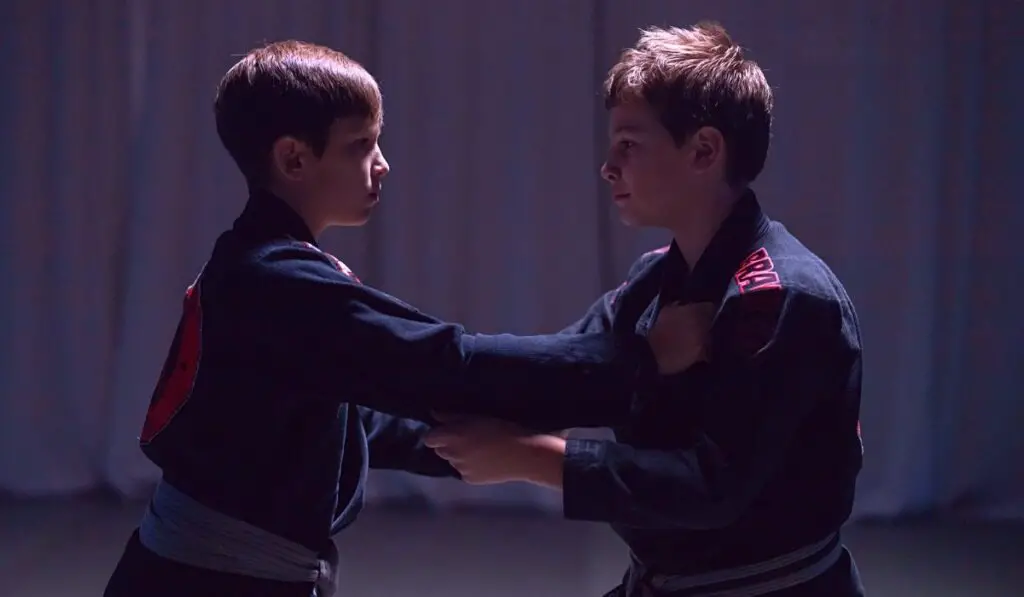As an avid practitioner of Brazilian jiu-jitsu and an upcoming competitor, you must be keen to find out what is required to earn an IBJJF belt. Athletes from white to red belts need to adhere to the IBJJF belt graduation system.
The IBJJF Ranking System provides guidelines and criteria for grading expertise in Brazilian Jiu-Jitsu. It is designed to promote the standardization of teaching, training, and competition in this martial art.
Having a good understanding of the IBJJF belt requirements and graduation system is necessary. It will help you establish realistic objectives and work your way up the ranks of this intricate grappling art. Read on to find out more!
Understanding the BJJ Belt System
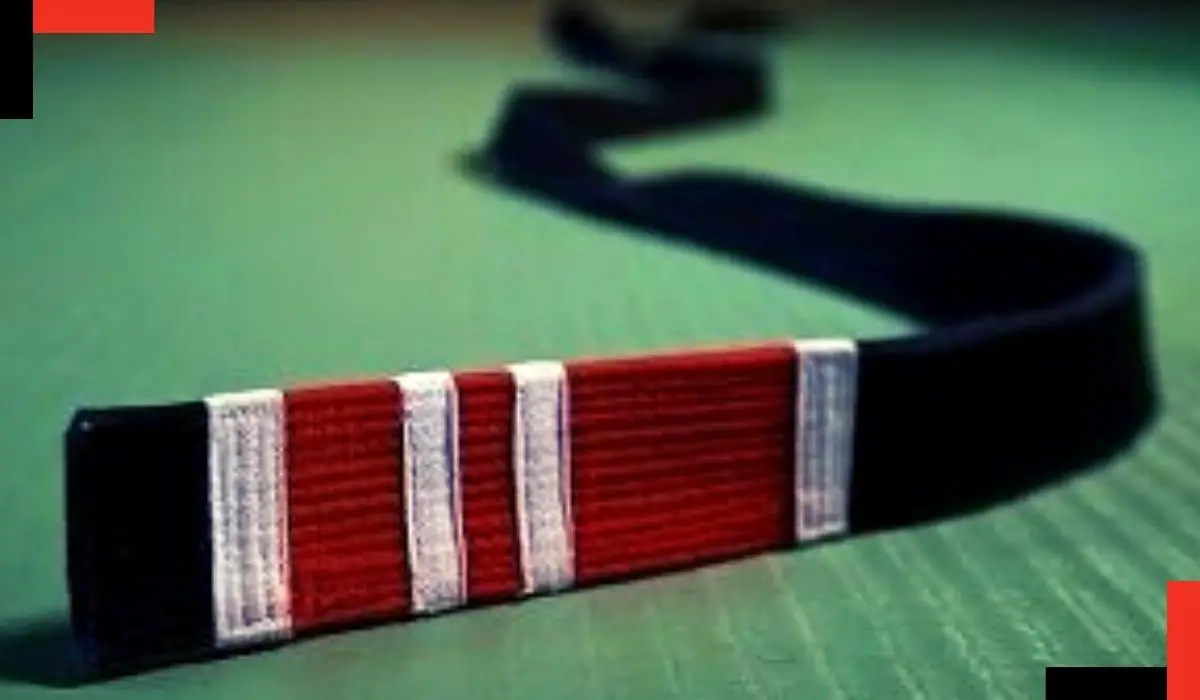
Have you ever thought about what the IBJJF belt system stands for? It is much more than just shades and ranks. It is a representation of the journey of a student, from an amateur to a proficient master. Let us delve deeper into its meaning.
There are two distinct divisions for belt rankings in Brazilian jiu-jitsu, which come with varied regulations and needs: those for Kids and Adults.
Kids’ BJJ Belt Ranks
The Brazilian jiu-jitsu belts system for kids is divided into five colors: White, gray, yellow, orange, and green. This system is specifically for those between the ages of 4 to 15.
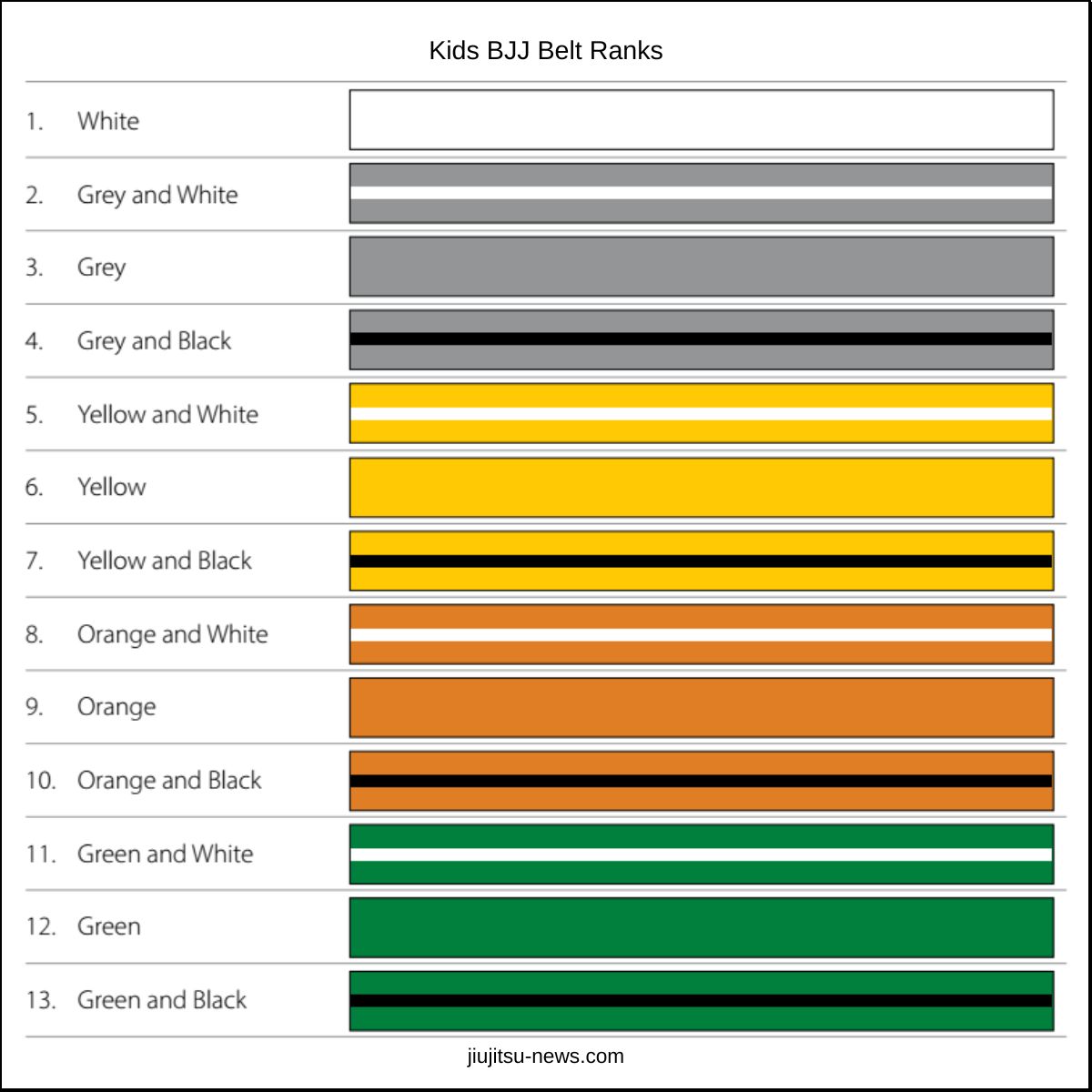
Adult BJJ Belt Ranks
The Brazilian jiu-jitsu belt system for adults consists of eight different colors: White, blue, purple, brown, black, red/black, red/white, and red. These levels are for participants who are at least 16 years old.

IBJJF Belt Size Requirements
The IBJJF outlines the dimensions and features of belts for adult and children Brazilian jiu-jitsu competitors.
Kids BJJ Belt Size Requirements
The belts of athletes in the age group of 04 to 15 years should have a width of 2.5 cm (0.98 in) to 3.5 cm (1.38 in). The black bar should measure around 10 cm (3.94 in) and should be situated between 2 cm (0.79 in) and 3 cm (1.18 in) from one end.
Otherwise, only white, black, or the same color as the rest of the belt is permissible to exist in the middle of a belt running its entire length.
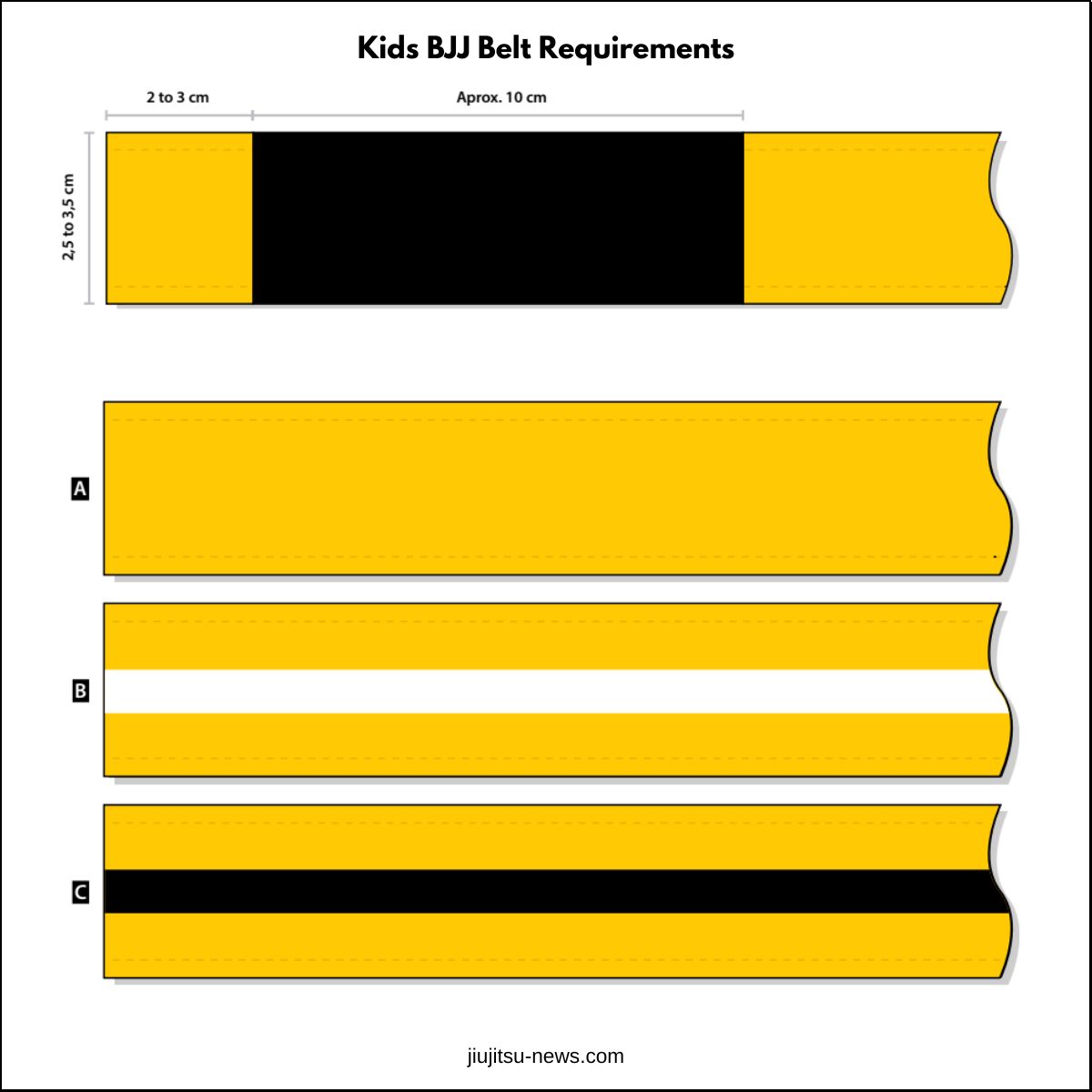
Adult BJJ Belt Size Requirements
- White to Brown Adult BJJ Belt Size Requirements
Adult athlete belts from white to brown belts should measure between 3.5 cm (1.38 in) and 4.5 cm (1.77 in) in width.
Otherwise, the belt’s end should have a black bar of about 10 cm (3.94 in) in size, which should be situated in a range of 2 cm (0.79 in) to 3 cm (1.18 in).

- Black Adult BJJ Belt Size Requirements
The black belt should feature a red bar running 10 cm (3.94 in) long which should be placed at a distance of 2 cm (0.79 in) to 3 cm (1.18 in) from the end.
Otherwise, two white stripes should outline the black belt to receive from one to six degrees.

- Red and Black Belt / Red and White Belt Size Requirements
Belts of the 7th and 8th Degrees are 3.5 cm (1.38 in) to 4.5 cm (1.77 in) wide, with alternating colors of Red and Black (7th Degree) and Red and White (8th Degree).
A white bar of around 15 cm (5.91 in) should be situated at 2 cm (0.79 in) to 3 cm (1.18 in) from the belt’s closure. Two silver bars are present, and red bars are placed between them to designate the rank.
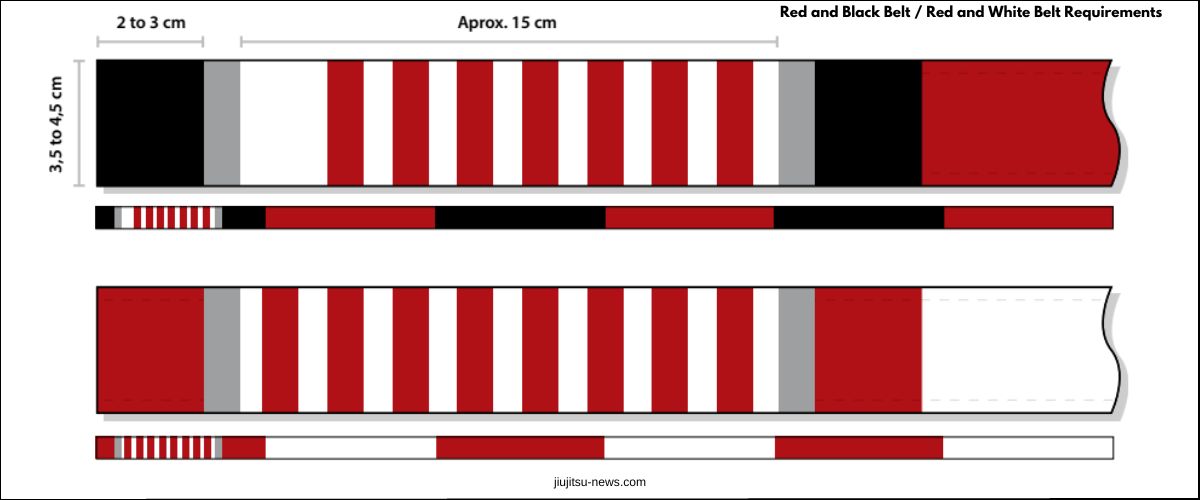
- Red Belt Size Requirements
.A Grand Master who holds the 9th or 10th Degree wears a red belt with a white bar measuring 15 cm (5.91 in) in length, situated between 2 cm (0.79 in) to 3 cm (1.18 in) from the belt’s end.
Otherwise, this white bar should be bordered by two gold stripes, each 2 cm (0.79 in) wide, where the degrees are marked in red.

IBJJF Belt Promotion Age Requirements
The IBJJF has established age limits for each belt rank in Brazilian Jiu-Jitsu. These regulations are made to guarantee that competitors are considered adequately experienced and mature for the belt they are achieving.
- Kids’ Graduation Age requirements
Athletes between the ages of 4 and 15 should follow the below-age belt progression age requirements :
| Kids Belt Group | Age Range |
| White Belt | Any age |
| Gray Group (Gray and White Belt, Gray Belt, Gray, and Black Belt) | 4-15 years |
| Yellow Group (Yellow and White Belt, Yellow Belt, Yellow and Black Belt) | 7-15 years |
| Orange Group (Orange and White Belt, Orange Belt, Orange and Black Belt) | 10-15 years |
| Green Group (Green and White Belt, Green Belt, Green and Black Belt) | 13-15 years |
- Adult Graduation Age requirements
Athletes aged 16 and above are required to abide by the age-related requirements for belt progression as set out in the table below.
| Adult Belt Color | Age Requirement |
|---|---|
| White Belt | Any age |
| Blue Belt | 16 years old or older |
| Purple Belt | 16 years old or older |
| Brown Belt | 18 years old or older |
| Black Belt | 19 years old or older |
| Red and Black Belt | 50 years old or older |
| Red and White Belt | 57 years old or older |
| Red Belt | 67 years old or older |
N.B: The age of the athlete in the IBJJF system is calculated by subtracting their birth year from the current year.
IBJJF Belt Time Requirements
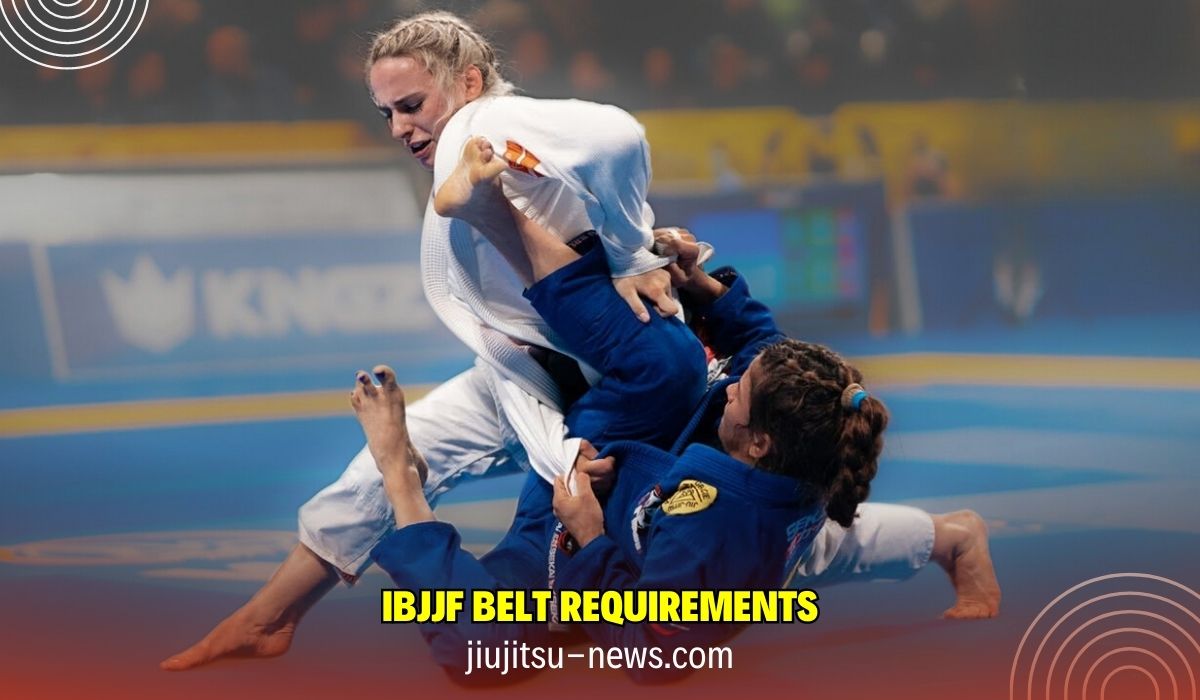
In order to advance in rank, the BJJ practitioner must remain in their current rank for the requisite period of time as set forth by the IBJJF. The following is a breakdown of the promotion time requirements:
Kids Belt Time Requirements
Children between the ages of 4 and 15 do not have to adhere to a minimum time requirement within each belt level.
Athletes Aged Between 16 and 17 Belt Time Requirements
- Adult white and blue belts time requirements: White and blue belt ranks have no minimum age to move to the next level.
- Adult Purple Belt time requirements: A competitor with a purple belt ranking can only be eligible for the brown belt when they are 18 years of age or older.
Athletes Aged 18 Years old and Above Belt Time Requirements
- White Belt Time Criteria: White belts have no minimum time criteria to reach the next belt rank.
- Blue Belt Time Criteria: A blue belt aged 18 or older should stay at least two years at this rank to get promoted. However, an athlete previously registered as a gray, yellow, or orange belt, needs only one year to get enabled. Aside from that, there is no maximum period if the athlete was previously registered as a green or blue belt Juvenile.
- Purple Belt Time Criteria: A purple belt aged 18 or older should stay at least one year and a half at this rank to get promoted. However, if he was previously registered as a blue-belt juvenile, the athlete will need only one year. Aside from that, there is no maximum period if the athlete was previously registered as an orange, green belt, or purple belt Juvenile.
- Brown Belt Time Criteria: A brown belt aged 18 or older should stay at least one year at this rank to get promoted. However, there is no maximum period for an adult brown belt world champion.
- Black Belt Time Criteria: A black belt needs at least 31 years to be promoted to the coral belt.
- Coral Belt Time Criteria: Red and black belts must stay at least 7 years in rank. However, red and white belts need 10 years and more to reach the red belt.
- Red Belt Time Requirements: There is no defined time for the red belt.
Conclusion
The IBJJF Graduation System establishes guidelines and regulations for achieving a belt ranking in Brazilian jiu-jitsu. This system is used to provide that practitioners of modern Jiu-Jitsu are learning, practicing, and competing according to the same standards.
Comprehending the IBJJF belt system, necessary time commitment, and age limitations can be instrumental in helping you set achievable objectives and strive to reach the highest levels of this complex martial art.
No matter where you are on your BJJ path, whether just beginning as a white belt or already experienced with the goal of earning a black belt, immersing yourself in the requirements and dedicating yourself to training will bring you closer to your goals.
Related: This article delves into the Brazilian jiu-jitsu belt ranking system. It emphasizes the meaning of the belts and the progression timeline to help you have the best training experience possible. Learn More Right Now!
Frequently Asked Questions

What Is the IBJJF Graduation System?
The IBJJF Graduation System is a set of rules and requirements for ranking in Brazilian jiu-jitsu. It helps standardize the teachings, practice, and competition of modern Jiu-Jitsu.
How Does the IBJJF Graduation System Standardize the BJJ Practice?
The IBJJF belt and rank system provides a guideline for BJJ practitioners, with a set of criteria for each rank such as age limitations, duration of time spent at a given rank, and belt size.
This structure allows practitioners to have a better understanding of what is required of them and to easily set goals that can be achieved to progress.
What Are the IBJJF Requirements to Get a Blue Belt?
Athletes who are at least 16 years old are eligible to achieve a blue belt in the IBJJF system. There is no set duration; one must remain at the white belt level before moving up to the next rank of a blue belt.
What Are the IBJJF Requirements to Get a Purple Belt?
One must be at least 16 years old to be eligible for a purple belt in the IBJJF system. But, an athlete with a blue belt aged 18 or more must remain at this level for a minimum of two years before being eligible for promotion.
However, those blue belts aged 18 or older who have been registered as gray, yellow, or orange belts need only one year in minimum for the purple belt. Otherwise, there is no set time limit to progress if the athlete’s previous belt qualification was green or blue as a juvenile.
What Are the IBJJF Requirements to Get a Brown Belt?
An adult athlete should be at least 18 years old to obtain a brown belt in the IBJJF system. A purple belt aged 18 and above must maintain the rank for at least a year and a half before advancing to the brown belt.
Though if the athlete was previously registered as a blue-belt juvenile, then only one year is required. Otherwise, if the athlete has been registered as an orange, green, or purple belt Juvenile, there is no maximum period for them to stay at the rank.
What Are the IBJJF Black Belt Requirements?
To receive a black belt in the IBJJF system, one must be at least 19 years old. If an adult brown belt is 18 or older, they must be at that level for a minimum of one year before advancing. There is no set limit of time for adult brown belt world champions.
What Is the Minimum Time Required to Spend at a Certain Belt Level According to IBJJF Rules?
| Age Group | Belt | Minimum Time to Get Promoted |
|---|---|---|
| 04 to 15 years old | All Belts | No minimum period |
| 16 and 17 years old | White Belt | No minimum time |
| 16 and 17 years old | Blue Belt | No minimum time |
| 16 and 17 years old | Purple Belt | Eligible for the brown belt once 18 years old |
| 18 years old and above | White Belt | No minimum time |
| 18 years old and above | Blue Belt | – 2 years – 1 year if previously registered in the IBJJF system as a gray, yellow, or orange belt. – No minimum if previously registered as Green belt or blue belt Juvenile or if the adult blue belt world champion |
| 18 years old and above | Purple Belt | – 1.5 years – 1 year if previously registered in the IBJJF system as a blue belt juvenile. – No minimum if previously registered as an orange or green belt or Juvenile blue belt. Also, if the adult purple belt is a world champion. |
| 18 years old | Brown Belt | – 1 year – No minimum if the adult brown belt world champion. |
| 18 years old | black elt | 31 years |
| 18 years old | Red and Black Belt | 7 years |
| 18 years old | Red and White Belt | 10 years |
| 18 years old | Red Belt | Undefined |
What’s the IBJJF Belt Size and Length Requirement?
| Belt Category | Belt Size Requirements |
|---|---|
| Kids BJJ (04 to 15 years old) | – Width: 2.5 cm (0.98 in) to 3.5 cm (1.38 in). – Black bar: 10 cm (3.94 in), situated between 2 cm (0.79 in) and 3 cm (1.18 in) from one end. – Only white, black, or the same color as the rest of the belt is permissible to exist in the middle of a belt running its entire length. |
| Adult BJJ (White to Brown) | – Width: 3.5 cm (1.38 in) to 4.5 cm (1.77 in). – Black bar: 10 cm (3.94 in), situated between 2 cm (0.79 in) and 3 cm (1.18 in) from one end. |
| Adult Black Belts | – Width: 3.5 cm (1.38 in) to 4.5 cm (1.77 in). – Red bar: 10 cm (3.94 in), situated between 2 cm (0.79 in) and 3 cm (1.18 in) from one end. Outlined by two white stripes to receive from one to six degrees. |
| Red and Black Belt / Red and White Belt (7th and 8th Degrees) | – Width: 3.5 cm (1.38 in) to 4.5 cm (1.77 in). – White bar: 15 cm (5.91 in), situated at 2 cm (0.79 in) to 3 cm (1.18 in) from the belt’s closure. – Two silver bars are present, and red bars are placed between them to indicate rank. |
| Red Belt (9th or 10th Degree) | – Width: 3.5 cm (1.38 in) to 4.5 cm (1.77 in). – White bar: 15 cm (5.91 in), situated between 2 cm (0.79 in) to 3 cm (1.18 in) from the belt’s end. This white bar should be bordered by two gold stripes, each 2 cm (0.79 in) wide, where the degrees are marked in red. |
Can I Skip a Belt Rank in BJJ?
It is almost impossible to bypass a belt grade in BJJ since the belt system is created to aid students in building a solid foundation for each level. Going up the ranks allows for a steady increase in knowledge and expertise.
Are There Age Restrictions for Belt Promotions in BJJ?
IBJJF has established age criteria for each belt grade, something that many dojos adhere to. This is to guarantee that students have gathered enough knowledge and have grown up enough before advancing to the next stage.


